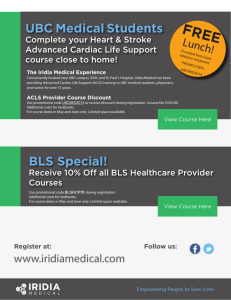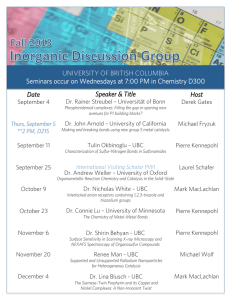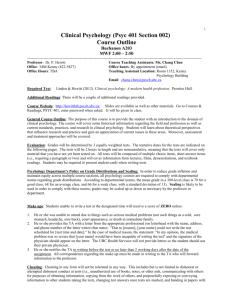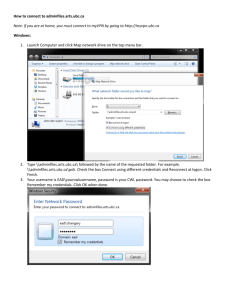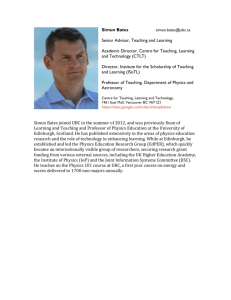EPSE 311- Syllabus
advertisement
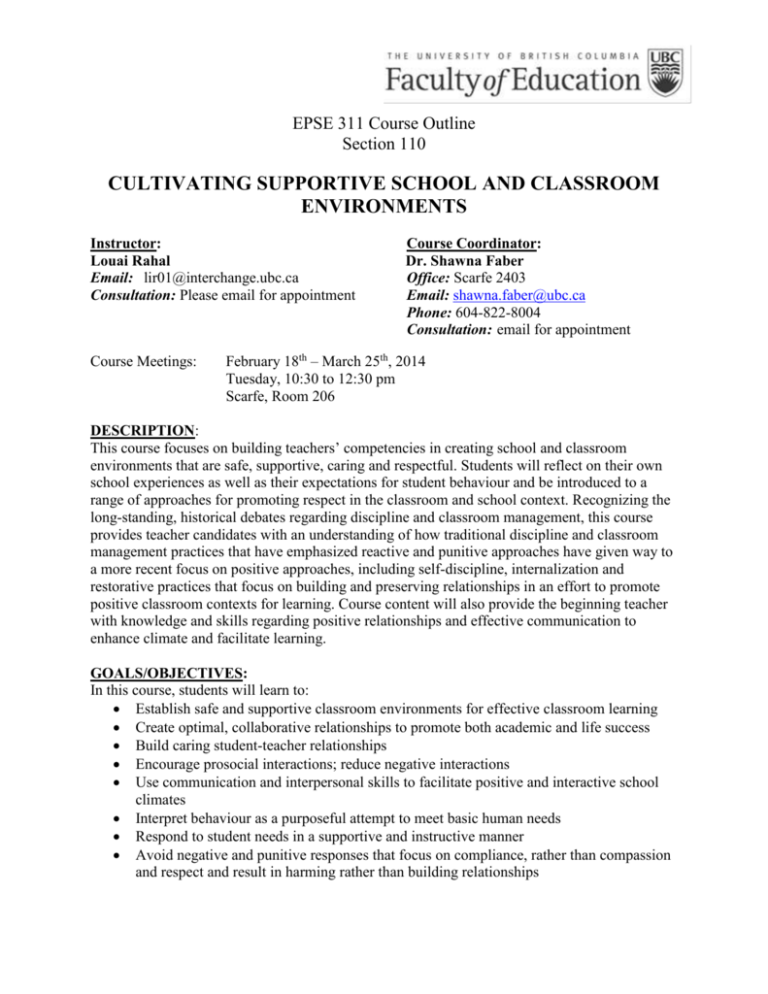
EPSE 311 Course Outline Section 110 CULTIVATING SUPPORTIVE SCHOOL AND CLASSROOM ENVIRONMENTS Instructor: Louai Rahal Email: lir01@interchange.ubc.ca Consultation: Please email for appointment Course Meetings: Course Coordinator: Dr. Shawna Faber Office: Scarfe 2403 Email: shawna.faber@ubc.ca Phone: 604-822-8004 Consultation: email for appointment February 18th – March 25th, 2014 Tuesday, 10:30 to 12:30 pm Scarfe, Room 206 DESCRIPTION: This course focuses on building teachers’ competencies in creating school and classroom environments that are safe, supportive, caring and respectful. Students will reflect on their own school experiences as well as their expectations for student behaviour and be introduced to a range of approaches for promoting respect in the classroom and school context. Recognizing the long-standing, historical debates regarding discipline and classroom management, this course provides teacher candidates with an understanding of how traditional discipline and classroom management practices that have emphasized reactive and punitive approaches have given way to a more recent focus on positive approaches, including self-discipline, internalization and restorative practices that focus on building and preserving relationships in an effort to promote positive classroom contexts for learning. Course content will also provide the beginning teacher with knowledge and skills regarding positive relationships and effective communication to enhance climate and facilitate learning. GOALS/OBJECTIVES: In this course, students will learn to: Establish safe and supportive classroom environments for effective classroom learning Create optimal, collaborative relationships to promote both academic and life success Build caring student-teacher relationships Encourage prosocial interactions; reduce negative interactions Use communication and interpersonal skills to facilitate positive and interactive school climates Interpret behaviour as a purposeful attempt to meet basic human needs Respond to student needs in a supportive and instructive manner Avoid negative and punitive responses that focus on compliance, rather than compassion and respect and result in harming rather than building relationships The course will include a combination of didactic components, practical activities, roleplays/scenarios, and facilitated small group discussions. These goals and objectives will be successfully achieved through your attendance and participation in class activities and discussions, in addition to readings and assignments. Assignments and Expectations: Professionalism (Attendance, Informed Discussion, and Supportive Participation) (20%) One measure of acceptable teaching is being professional. This means (among other things) honoring your commitments; being where you are supposed to be when you are supposed to be there; turning in assignments on or before due dates; asking other students and/or the instructor for assistance with assignments where needed; coming to class ON TIME; pre-arranging childcare and medical appointments that do not interfere with the program; e-mailing your instructors if you will be absent (prior to your absence); and being neat, accurate and coherent in your written and oral presentation. Emergency situations will be taken into account. Professionalism also includes being respectful to other students and involvement. Involvement means coming to class prepared (i.e. do your readings, bring required items), getting involved in class discussions (participate!), sharing ideas, taking initiative in and resolving conflicts when working individually or in group projects, volunteering for and contributing over and above requirements. This also means remembering to shut off your cell phones and not texting, emailing or browsing the internet during class. This course will be conducted in a seminar fashion and your role as a participant is vital to this process. Therefore, attendance is mandatory and will be taken daily. Students are expected to stay for the entire class session. Excessive tardiness, lack of preparation or active attention (e.g. texting or surfing the net) will result in a significant reduction in points. Reading Activities (30%) All class readings can be found online on our dropbox site at: bit.ly/1iJhdGI You will be assigned to a reading group—either Group A or Group B. This reading group will determine which article/s you are responsible to read for each unit (of course you may read both readings if you like). For this assignment you have the opportunity to deeply consider the course readings to begin to build your own perspective on how to create a positive classroom environment. Before each class you are expected to read the article assigned to you, and complete the activity listed in the course outline for that week. Please read the reading response activity carefully (listed under the unit) as each week you can expect to do something different with the readings. Your reading activities will help you with your final assignment so please keep a copy of these. 2 Final Assignment: Moving Beyond Classroom Management (50%) On the basis of research and theory regarding the importance of the classroom as a safe, caring and respectful learning environment, you will create a detailed description of how you will ideally structure your own future classroom context to optimize student academic and social and emotional learning. Based on your reading activities and what you have learned in this class you will create a plan of how you will move beyond classroom management and create a positive classroom environment that fits with your teaching philosophy. You will also include an example of a difficult situation and give two ways that you could respond to that situation. You have the option of working on your own or in pairs on this assignment (but if you choose to work in pairs be sure to find someone who shares a similar teaching philosophy). The specific assignment criteria and grading is as follows: 1. How I plan to move beyond Classroom Management (10%) Describe WHY you would want to create a classroom environment that focuses on more than just classroom management. Include the following: a. Your basic teaching philosophy b. Research based findings (learned in EPSE 311) 2. My plan for creating and maintaining a positive classroom environment that fits with my teaching philosophy (20%) Describe HOW you plan to create positive classroom environments. Include details (a strategy/idea for each of the following) on how you ideally plan to: a. Create supportive and safe environments b. Build relationships c. Foster SEL d. Prevent problems Note: Be sure that your plan fits with your teaching philosophy (as stated in part 1) 3. My ideas on how to handle a difficult situation (20%) Write up a short case of a difficult situation you have witnessed during your class visits (or one that you haven’t seen but are worried about). Come up with two ways that you would attempt to deal with that difficult situation. Include: a. Clear example case of difficult situation/behaviour b. First example of how you might successfully address the situation/behaviour c. Second example of how you might address the situation/behaviour Note: Be sure that your solutions fit with how you stated you would set up your environment and with your teaching philosophy Draft Outline of Final Assignment Due: Tuesday, March 18th. 3 Final Assignment Submission notes: 1. This assignment is due at the beginning of the last class. If you are concerned that you will be late for class please submit your assignment via email before class start (but still bring a hard copy with you to class) 2. Please double space your assignment (although your case can be single spaced if you like)—12 point font is preferred 3. Please reference where you are citing research rather than giving your own opinion (any referencing style is fine as long as you are clear and consistent) 4. A reference page is not required unless you are bringing in sources outside of the research covered in class—again, any referencing style is acceptable as long as anyone could easily find your sources. Final Assignment Due in hard Copy: Tuesday, March 25th ACADEMIC HONESTY AND LATE SUBMISSIONS Students are expected to complete their own work and to submit work that has been prepared for this class only. Submitting or presenting the work of another person as if it were one’s own (plagiarism), or submitting work prepared for another class will result in an automatic failure. Accordingly, it is critical that you acknowledge your sources, including online sources. o Whether intentional or unintentional, plagiarism is a form of cheating that can lead to a failing grade for the course and to suspension from the University. As defined within UBC, plagiarism is a serious “form of academic misconduct in which an individual submits or presents the work of another person as his or her own”. As a form of intellectual theft, plagiarism involves taking the words, ideas or research of another without properly acknowledging the original author. Students should become familiar with the many different forms that plagiarism can take, including accidental and intentional plagiarism. For more information on UBC policies regarding plagiarism, see the following links: o ECPS Policy on Plagiarism: http://ecps.educ.ubc.ca/faculty-staff/faculty/policiesprocedures/ecps-policy-on-plagiarism/ o UBC Learning Commons http://learningcommons.ubc.ca/resource-guides/avoidingplagiarism/ o UBC library site: http://help.library.ubc.ca/planning-your-research/academicintegrity-plagiarism/ You are expected to submit all course work by the due date specified, unless arranged with the instructor at least one week in advance. Any late assignments that have not been previously discussed with your instructor will result in a failure on that assignment. AWARDING FINAL GRADES The pass/fail system in this faculty requires a 76%, which is a B+, or better for a passing grade. For this course, only “pass” or “fail” will appear on your transcript. All assignments must meet the 76% standard in order to obtain a passing grade in this class. In a professional 4 faculty, passing a course entails both good academic performance as well as active participation in learning activities. Students are expected to meet all criteria to receive a passing mark. If an assignment does not meet expected standards you have ONE opportunity to revise and resubmit an assignment. Attendance and participation are essential to the experiential learning that is necessary within a professional program. You are expected to attend all classes. If you are absent from class you must inform your instructor via e-mail (mbwteach@gmail.com) within 24 hours of the missed class. More than one missed class will require a doctor’s note. If a student misses more than one class, the instructor must inform the Teacher Education Office and the teacher candidate most likely will need to repeat the course. Full details regarding Attendance and participation are described in the B.Ed. Program handbook found at: http://teach.educ.ubc.ca/resources/pdfs/guides/BEd-Policy-Handbook-2011.pdf Attendance will be taken in every class. Additional Important Policies: Please also be aware of the following UBC, ECPS, and Teacher Education Policies: Academic Integrity The integrity of academic work depends on the honesty of all those who work in this environment and the observance of accepted conventions concerning such practices as acknowledging the work of others. Plagiarism and other forms of academic misconduct are taken very seriously at UBC, whether committed by faculty, staff or students. You should be aware of the sections of the University Calendar that address academic misconduct: www.students.ubc.ca/calendar and of the university’s website on scholarly integrity: http://clc.library.ubc.ca/airc.html. The UBC library also has a useful webpage on plagiarism and how to avoid it: www.library.ubc.ca/home/plagiarism/. If you have questions or concerns about any of these policies or conventions in relation to how they apply to the work you do in this course, please discuss them with me. Gender Inclusive Language Please incorporate and gender inclusive language in your oral and written language. This language positions women and men equally, it does not exclude one gender or the other, nor does it demean the status of one gender or another. It does not stereotype genders [assuming all childcare workers are female and all police officers are male], nor does it use false generics [using mankind instead of human kind, or using man-made instead of hand crafted]. In addition, this language requires gender balance in personal pronouns, for example, use "he and she" rather than "he" or balance gendered examples in a paper, referring to both male and female examples. You may also cast subjects in the plural form, for example, when a “student raises his hand” change to when “students raise their hands.” Person First Language Please incorporate and use person first language in your oral and written language. Disabilities and differences are not persons and they do not define persons, so do not replace person-nouns with disability-nouns. Avoid using: the aphasic, the schizophrenic, the hearing impaired. Also avoid using: the hearing impaired client, the dyslexic lawyer, the developmentally disabled adult. Instead, emphasize the person, not the disability, by putting the person-noun first: the lawyer 5 with dyslexia, the child with hearing impairment, the teacher with a physical impairment. Professional Conduct Teacher candidates in the Faculty of Education are expected to adhere to principles of professional conduct while on campus and in schools. They are also expected to adhere to the policy of the university regarding respectful learning environment. Participants in this course are expected to demonstrate all of the qualities of professionalism, arriving at each class fully prepared, engaging actively in the teaching and learning process and interacting ethically with your peers and your instructor. Classes will be conducted within an atmosphere of respect, both for each other and for the ideas expressed by participants in class discussions and debates. My responsibility in this class is to model professional conduct and to guide you to an understanding of professionalism when you are on campus, and when you are on practicum in schools. Students with Disabilities If you have a letter from the office of Access and Diversity indicating that you have a disability that requires specific accommodation, please present the letter to me so that we can discuss possible accommodation. To request academic accommodation due to a disability, first meet with an advisor in the Office of Access and Diversity to determine your eligible accommodations/ services. Please keep me and the Teacher Education office informed about requests for accommodation. 6 Unit 1: February 18 TIMETABLE Topic: Classroom Environment: Where We’ve Been and Where We’re Going Envisioning Classroom Environments Historical Approaches to Discipline; Recent Approaches to Community Building and Restorative Practices Reading: Groups A & B: Linsin, M. (2009). How to build classroom community: It’s not what you think. SCM, Online. Activity: Creating a positive learning environment Unit 2: February 25 Topic: Building Classroom Communities Setting up Classrooms for Success Establishing Collaborative Communication to Facilitate Student Learning Readings: Group A: Martin, S. D. (2004). Finding balance: Impact of classroom management conceptions on developing teacher practice. Teaching and Teacher Education, 20, 405-422. Group B: Watkins, C. (2006). Classrooms as learning communities: A review of research. London Review of Education, 3(1), 47-64. Reading Activity: Read the assigned article and send an email to your instructor (by Sunday February 23rd before midnight) with the following: A critical question or thought provoking comment about the article. AND one of the following: A link, snapshot, or an online copy of recent news/media coverage about an issue that strongly relates to this week’s reading. or A brief paragraph describing what stood out to you in this week’s readings and why? Your emailed questions/contributions will be compiled and presented in class as possible topics for our group discussions. This reading assignment should be completed and sent before midnight on Sunday February 23rd. 7 Unit 3: March 4 Topic: Establishing Supportive Environments School-wide Approaches to Creating Safe and Caring Environments Building Positive Student-Teacher Relationships Reading: Group A: Bergin, C., & Bergin, D. (2009). Attachment in the classroom. Educational Psychology Review, 21, 141-170. Group B: Hamre, B. K., & Pianta, R. C. (2006). Student-teacher relationships. In G. G. Bear & K. Minke (Eds.), Children’s Needs III: Development, prevention, and intervention (pp. 59-71). Bethesda, MD: NASP. Reading Activity: Read the article assigned to your group and acting as a teacher devise 3 questions you would ask about this article if you were giving a quiz on the content. The questions you devise should be in multiple choice format (with a question and possible answers from a-d), e.g., : 1. Question/Stem a. Possible answer b. Possible answer c. Possible answer d. Possible answer Write each of your questions on a separate slip of paper —be sure to include your name on each question as well as the answer to the question. Your questions need to be submitted in hard copy format at the start of class. 8 Unit 4: March 11 Topic: Fostering Socio-Emotional Competencies Selecting Social-Emotional Learning Curricula Teaching Social-Emotional Competencies as a Foundation for Supportive Environments Reading: Group A: Norris, J. A. (2003). Looking at classroom management through a social and emotional learning lens. Theory into Practice, 42, 313-318. Group B: Jennings, P. A., & Greenberg, M. T. (2008). The prosocial classroom: Teacher social and emotional competence in relation to student and classroom out comes. Review of Educational Research, 79, 491-525. Unit 5: March 18 Reading Activity: Prepare a summary/memo of your understanding of the reading. This memo should be one page maximum, but you may use bullet points (spelling/grammar are not important—just your thoughts on your reading). The focus of your memo should be how you can use what you are reading about in your own teaching—moving from theory to practice. Bring a hard copy of your memo to class. Topic: Preventing and Understanding Problem Behaviours Helping Students to Choose Better Responses Managing difficult behaviours Reading: Group A and B (read both articles): Gossen, D. (2007). Student behavior. International Journal of Reality Therapy, 27, 17-20. Noddings, N. (2006). Handle with care. Greater Good, 3(1), 18-21. Reading Activity: Read you assigned article and come up with three thoughts and one question you have about the articles. These should be written out and brought to class in hard copy format. Some questions to consider while you are reading: What did you learn from this article and what do you want others to learn from it? How do you see theory relates to practice in this article? Do you agree or disagree with the author and why? Assignment: Outline of Final Assignment Due (in hard copy format) 9 Unit 6: March 25 Topic: Enhancing student relationships—Reducing bullying Behaviour as Communicating Basic Human Needs Dealing with Bullying Reading: Group A: Yerger, W., & Gehret, C. (2011). Understanding and dealing with bullying in schools. The Educational Forum, 75, 315-326. Group B: Rodkin, P.C. (2011). Bullying—And the power of peers. Educational Leadership, 69, 10-16. Reading Activity: Linking your final activity to the reading—in-class discussion Be prepared to discuss how your case from your final activity relates to the readings. This might be how your case relates to bullying, prevents bullying or has an effect on relationships overall You may use your final assignment write-up to help guide your discussion Assignment: Final Project Due 10

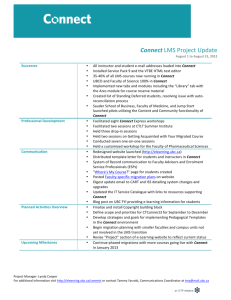
![July 31 Connect eupdate DRAFT [1]](http://s3.studylib.net/store/data/008100166_1-21bd0e395dcbfd67aaad5f18dd4ec08e-300x300.png)

